Abstract
1. We have examined the reflex changes in breathing evoked in anaesthetized dogs by stimulation of the afferent vagal C fibres that supply the intrapulmonary and lower extrapulmonary airways. We stimulated bronchial (intrapulmonary) C fibres selectively by injecting bradykinin into the right bronchial artery (the chest had been opened briefly for insertion of a bronchial arterial catheter).
2. Bronchial arterial injection of bradykinin (0·15-1·5 μg in 3-6 sec) usually caused a brief bout of rapid shallow breathing, which was sometimes preceded by apnoea. Infusion of bradykinin (0·2-2·0 μg min-1 for 2-12 min) caused prolonged rapid shallow breathing, the breathing frequency (f) increasing by 19-102% and tidal volume (VT) decreasing by 13-87%; end-tidal PCO2 decreased by 2-9 mmHg in several experiments. Rapid shallow breathing was also evoked by administration of bradykinin aerosol through a lower tracheal cannula.
3. Cutting the vagus nerves or cooling them to 0 °C abolished the prolonged rapid shallow breathing evoked by bradykinin, but intermittent disturbances of breathing could still be elicited in some dogs. These residual effects often consisted of irregular spasmodic inspirations, which were abolished by avulsion of the right upper thoracic sympathetic chain.
4. Rapid shallow breathing was accompanied by contraction of airway smooth muscle in an innervated segment of the upper trachea; contraction was abolished by cutting or cooling the vagus nerves.
5. Arterial blood pressure often decreased briefly when bradykinin was injected into the bronchial artery; changes in pressure were smaller and less frequent when bradykinin was infused slowly, and pressure was usually unaltered when bradykinin was administered as an aerosol. Rapid shallow breathing occurred whether pressure decreased, increased or was unchanged. A number of other observations indicated that the changes in breathing were independent of the changes in blood pressure. Changes in heart rate were complex and appeared to result from the interplay of several reflexes. Marked cardiac slowing was evoked by bradykinin aerosol.
6. Bradykinin injected into a bronchial artery is known to stimulate bronchial (intrapulmonary) C fibres. Results of recording afferent vagal impulses in the present study indicated that bradykinin administered as an aerosol stimulated bronchial C fibres and also C fibres with endings in the lower trachea and extrapulmonary bronchi. Irritant and pulmonary stretch receptors were not stimulated unless aerosols were administered repeatedly and in higher concentration. Hence airway C fibres appeared to be responsible for the reflex effects of bradykinin aerosol.
7. Bronchial C fibres are stimulated by substances (bradykinin, prostaglandins and histamine) known to be released by the lungs and airways in a variety of pathophysiological circumstances. Results of this and previous studies are compatible with the hypothesis that stimulation of bronchial C fibres plays a major role in evoking the rapid shallow breathing, bronchoconstriction and increased secretion by airway submucosal glands that are part of the pulmonary defence response.
Full text
PDF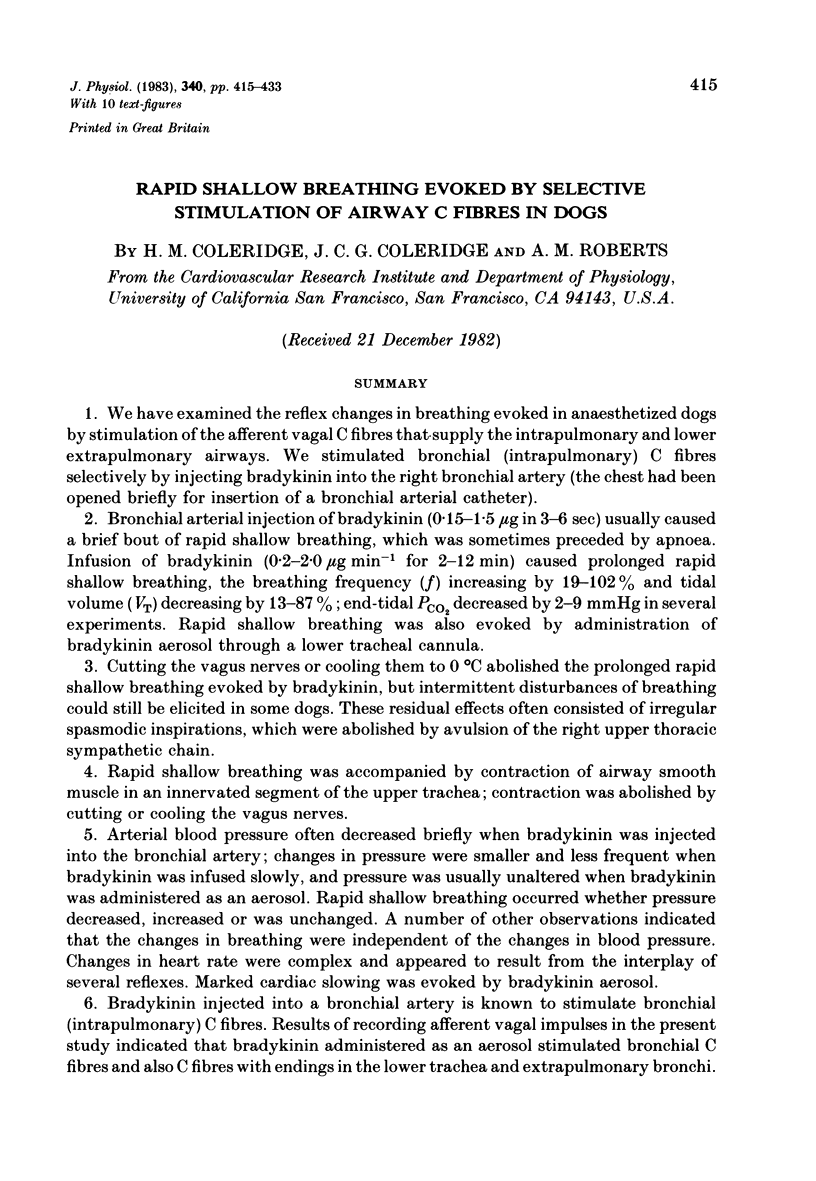


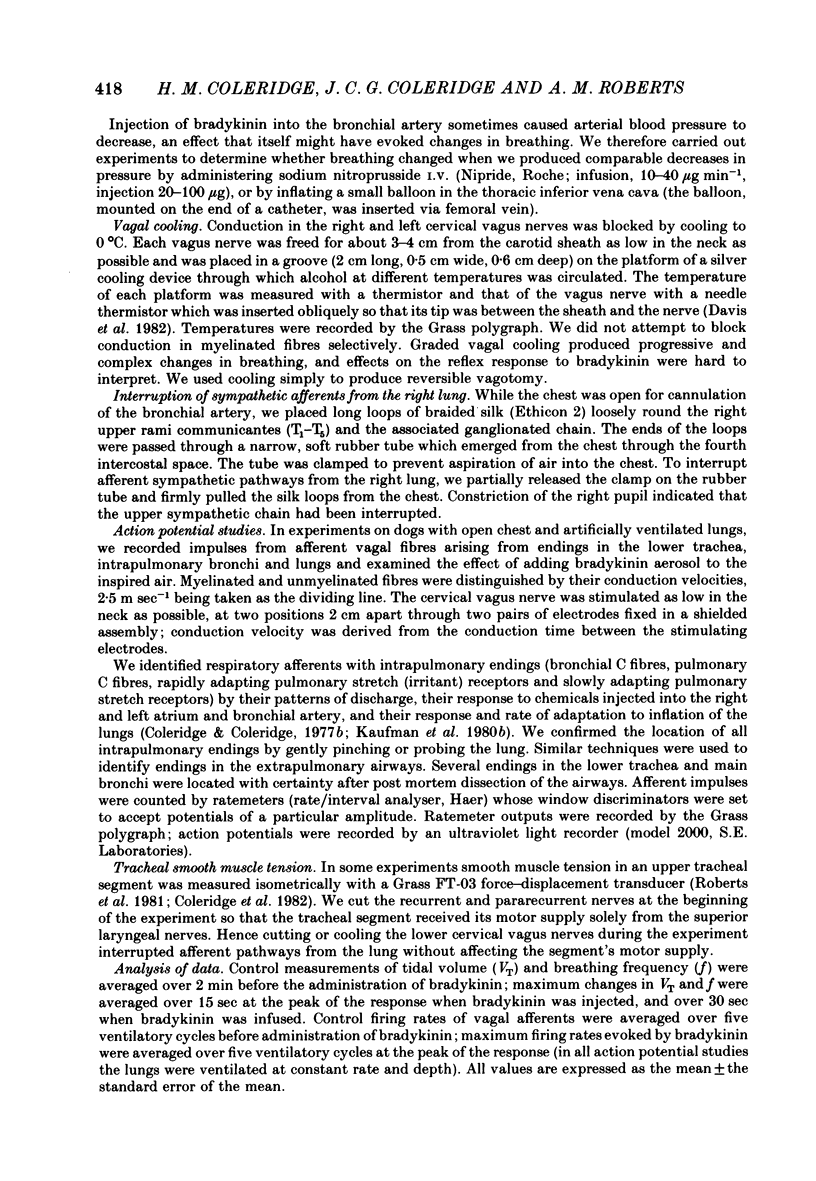

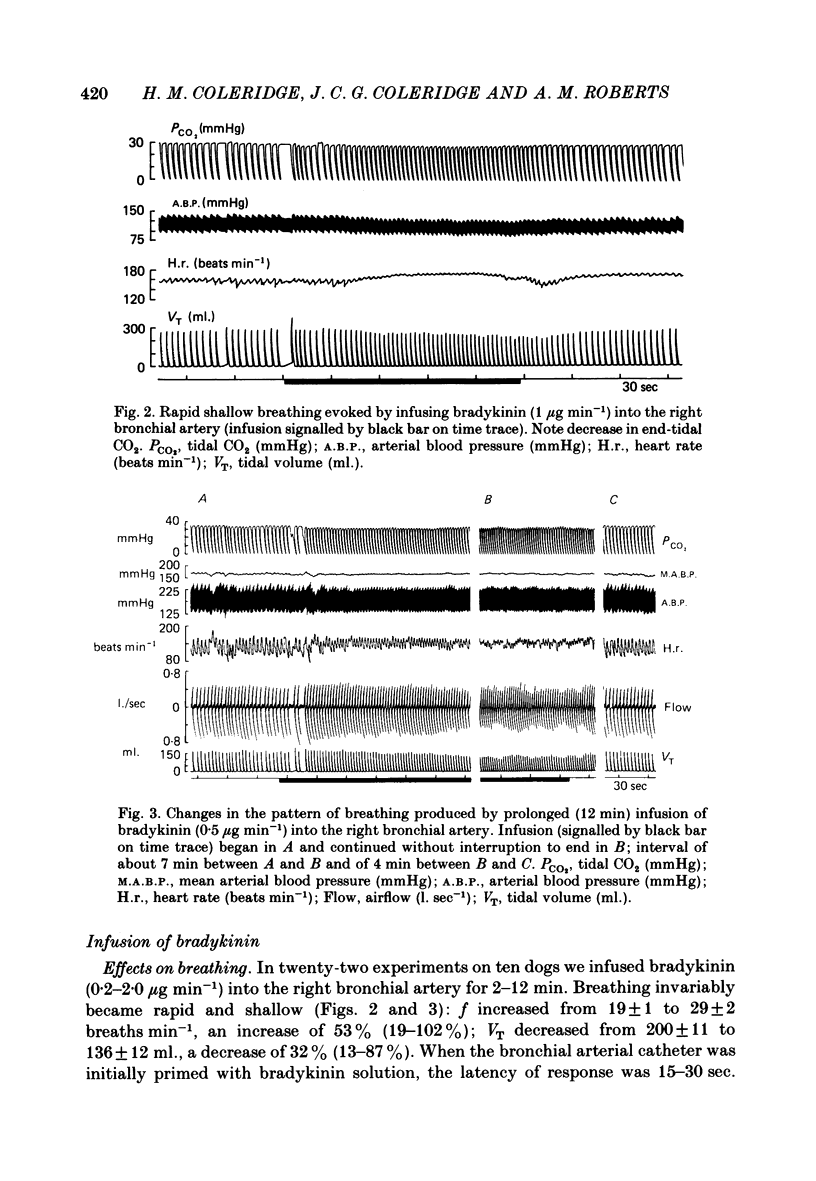
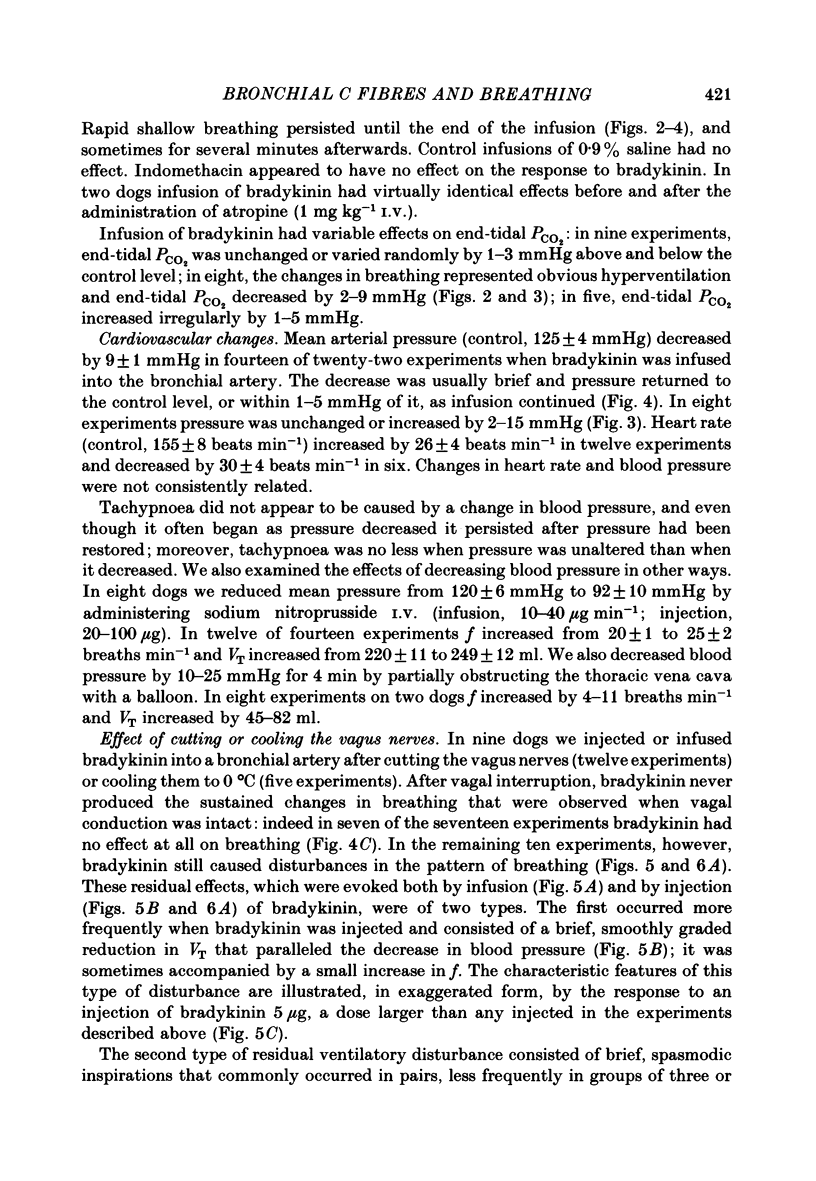









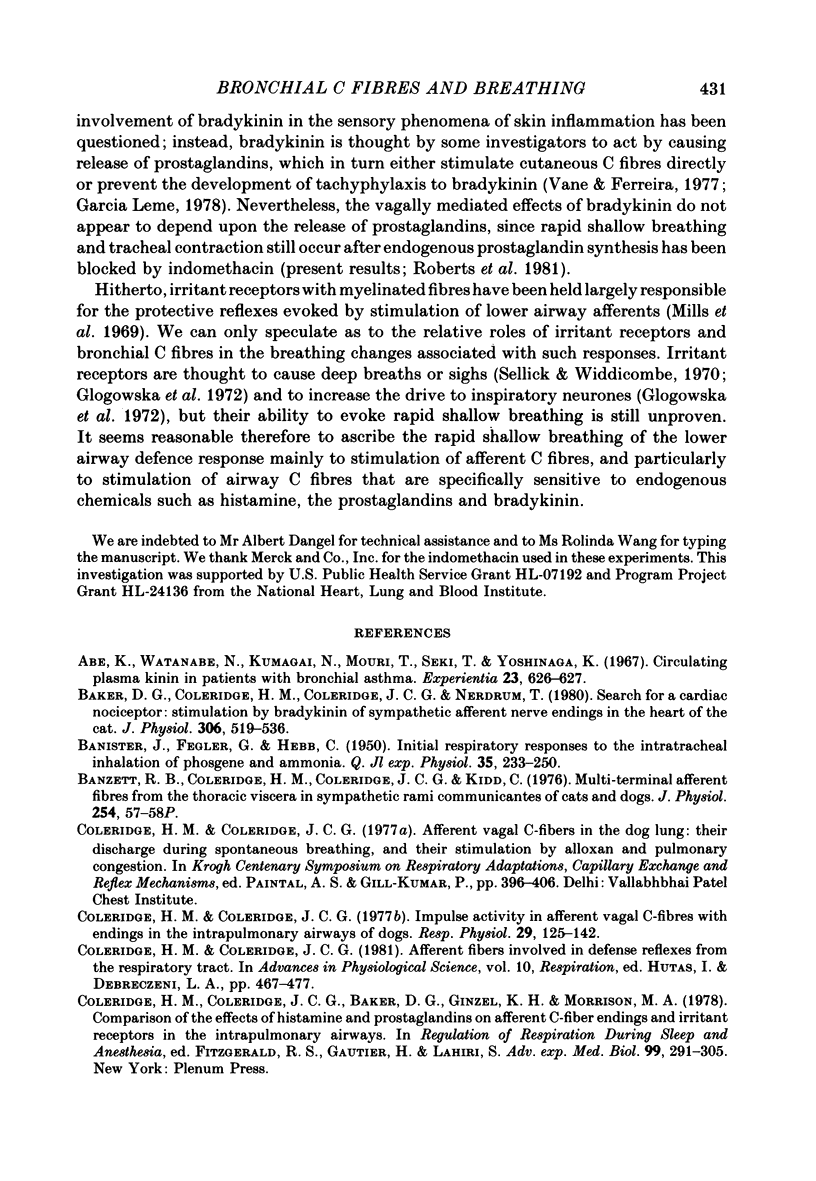
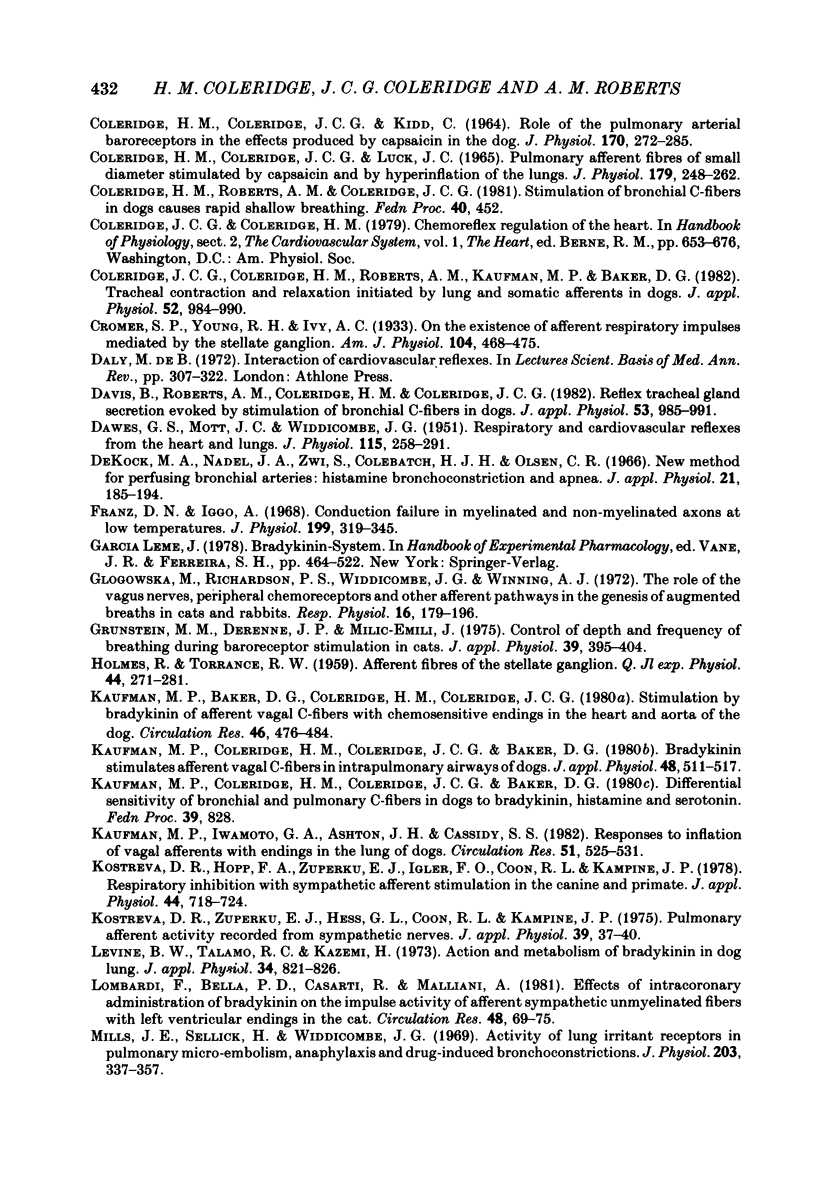

Selected References
These references are in PubMed. This may not be the complete list of references from this article.
- Abe K., Watanabe N., Kumagai N., Mouri T., Seki T., Yoshinaga K. Circulating kinin in patients with bronchial asthma. Experientia. 1967 Aug 15;23(8):626–627. doi: 10.1007/BF02144161. [DOI] [PubMed] [Google Scholar]
- BANISTER J., FEGLER G., HEBB C. Initial respiratory responses to the intratracheal inhalation of phosgene or ammonia. Q J Exp Physiol Cogn Med Sci. 1949 Nov;35(3):233-50, 7 pl. doi: 10.1113/expphysiol.1949.sp000952. [DOI] [PubMed] [Google Scholar]
- Baker D. G., Coleridge H. M., Coleridge J. C., Nerdrum T. Search for a cardiac nociceptor: stimulation by bradykinin of sympathetic afferent nerve endings in the heart of the cat. J Physiol. 1980 Sep;306:519–536. doi: 10.1113/jphysiol.1980.sp013412. [DOI] [PMC free article] [PubMed] [Google Scholar]
- Banzett R. B., Coleridge H. M., Coleridge J. C., Kidd C. Proceedings: Multi-terminal afferent fibres from the thoracic viscera in sympathetic rami communicantes of cats and dogs. J Physiol. 1976 Jan;254(1):57P–58P. [PubMed] [Google Scholar]
- COLERIDGE H. M., COLERIDGE J. C., KIDD C. ROLE OF THE PULMONARY ARTERIAL BARORECEPTORS IN THE EFFECTS PRODUCED BY CAPSAICIN IN THE DOG. J Physiol. 1964 Mar;170:272–285. doi: 10.1113/jphysiol.1964.sp007330. [DOI] [PMC free article] [PubMed] [Google Scholar]
- Coleridge H. M., Coleridge J. C., Baker D. G., Ginzel K. H., Morrison M. A. Comparison of the effects of histamine and prostaglandin on afferent C-fiber endings and irritant receptors in the intrapulmonary airways. Adv Exp Med Biol. 1978;99:291–305. doi: 10.1007/978-1-4613-4009-6_32. [DOI] [PubMed] [Google Scholar]
- Coleridge H. M., Coleridge J. C. Impulse activity in afferent vagal C-fibres with endings in the intrapulmonary airways of dogs. Respir Physiol. 1977 Apr;29(2):125–142. doi: 10.1016/0034-5687(77)90086-x. [DOI] [PubMed] [Google Scholar]
- Coleridge H. M., Coleridge J. C., Luck J. C. Pulmonary afferent fibres of small diameter stimulated by capsaicin and by hyperinflation of the lungs. J Physiol. 1965 Jul;179(2):248–262. doi: 10.1113/jphysiol.1965.sp007660. [DOI] [PMC free article] [PubMed] [Google Scholar]
- Coleridge J. C., Coleridge H. M., Roberts A. M., Kaufman M. P., Baker D. G. Tracheal contraction and relaxation initiated by lung and somatic afferents in dogs. J Appl Physiol Respir Environ Exerc Physiol. 1982 Apr;52(4):984–990. doi: 10.1152/jappl.1982.52.4.984. [DOI] [PubMed] [Google Scholar]
- DAWES G. S., MOTT J. C., WIDDICOMBE J. G. Respiratory and cardiovascular reflexes from the heart and lungs. J Physiol. 1951 Nov 28;115(3):258–291. doi: 10.1113/jphysiol.1951.sp004670. [DOI] [PMC free article] [PubMed] [Google Scholar]
- Davis B., Roberts A. M., Coleridge H. M., Coleridge J. C. Reflex tracheal gland secretion evoked by stimulation of bronchial C-fibers in dogs. J Appl Physiol Respir Environ Exerc Physiol. 1982 Oct;53(4):985–991. doi: 10.1152/jappl.1982.53.4.985. [DOI] [PubMed] [Google Scholar]
- DeKock M. A., Nadel J. A., Zwi S., Colebatch H. J., Olsen C. R. New method for perfusing bronchial arteries: histamine bronchoconstriction and apnea. J Appl Physiol. 1966 Jan;21(1):185–194. doi: 10.1152/jappl.1966.21.1.185. [DOI] [PubMed] [Google Scholar]
- Franz D. N., Iggo A. Conduction failure in myelinated and non-myelinated axons at low temperatures. J Physiol. 1968 Dec;199(2):319–345. doi: 10.1113/jphysiol.1968.sp008656. [DOI] [PMC free article] [PubMed] [Google Scholar]
- Glogowska M., Richardson P. S., Widdicombe J. G., Winning A. J. The role of the vagus nerves, peripheral chemoreceptors and other afferent pathways in the genesis of augmented breaths in cats and rabbits. Respir Physiol. 1972 Oct;16(2):179–196. doi: 10.1016/0034-5687(72)90050-3. [DOI] [PubMed] [Google Scholar]
- Grunstein M. M., Derenne J. P., Milic-Emili J. Control of depth and frequency of breathing during baroreceptor stimulation in cats. J Appl Physiol. 1975 Sep;39(3):395–404. doi: 10.1152/jappl.1975.39.3.395. [DOI] [PubMed] [Google Scholar]
- HOLMES R., TORRANCE R. W. Afferent fibres of the stellate ganglion. Q J Exp Physiol Cogn Med Sci. 1959 Jul;44:271–281. doi: 10.1113/expphysiol.1959.sp001400. [DOI] [PubMed] [Google Scholar]
- Kaufman M. P., Baker D. G., Coleridge H. M., Coleridge J. C. Stimulation by bradykinin of afferent vagal C-fibers with chemosensitive endings in the heart and aorta of the dog. Circ Res. 1980 Apr;46(4):476–484. doi: 10.1161/01.res.46.4.476. [DOI] [PubMed] [Google Scholar]
- Kaufman M. P., Coleridge H. M., Coleridge J. C., Baker D. G. Bradykinin stimulates afferent vagal C-fibers in intrapulmonary airways of dogs. J Appl Physiol Respir Environ Exerc Physiol. 1980 Mar;48(3):511–517. doi: 10.1152/jappl.1980.48.3.511. [DOI] [PubMed] [Google Scholar]
- Kaufman M. P., Iwamoto G. A., Ashton J. H., Cassidy S. S. Responses to inflation of vagal afferents with endings in the lung of dogs. Circ Res. 1982 Oct;51(4):525–531. doi: 10.1161/01.res.51.4.525. [DOI] [PubMed] [Google Scholar]
- Kostreva D. R., Hopp F. A., Zuperku E. J., Igler F. O., Coon R. L., Kampine J. P. Respiratory inhibition with sympathetic afferent stimulation in the canine and primate. J Appl Physiol Respir Environ Exerc Physiol. 1978 May;44(5):718–724. doi: 10.1152/jappl.1978.44.5.718. [DOI] [PubMed] [Google Scholar]
- Kostreva D. R., Zuperku E. J., Hess G. L., Coon R. L., Kampine J. P. Pulmonary afferent activity recorded from sympathetic nerves. J Appl Physiol. 1975 Jul;39(1):37–40. doi: 10.1152/jappl.1975.39.1.37. [DOI] [PubMed] [Google Scholar]
- Levine B. W., Talamo R. C., Kazemi H. Action and metabolism of bradykinin in dog lung. J Appl Physiol. 1973 Jun;34(6):821–826. doi: 10.1152/jappl.1973.34.6.821. [DOI] [PubMed] [Google Scholar]
- Lombardi F., Della Bella P., Casati R., Malliani A. Effects of intracoronary administration of bradykinin on the impulse activity of afferent sympathetic unmyelinated fibers with left ventricular endings in the cat. Circ Res. 1981 Jan;48(1):69–75. doi: 10.1161/01.res.48.1.69. [DOI] [PubMed] [Google Scholar]
- Mills J. E., Sellick H., Widdicombe J. G. Activity of lung irritant receptors in pulmonary microembolism, anaphylaxis and drug-induced bronchoconstrictions. J Physiol. 1969 Aug;203(2):337–357. doi: 10.1113/jphysiol.1969.sp008867. [DOI] [PMC free article] [PubMed] [Google Scholar]
- Nishino T., Honda Y. Changes in pattern of breathing following baroreceptor stimulation in cats. Jpn J Physiol. 1982;32(2):183–195. doi: 10.2170/jjphysiol.32.183. [DOI] [PubMed] [Google Scholar]
- PAINTAL B. A. Impulses in vagal afferent fibres from specific pulmonary deflation receptors: the response of these receptors to phenyl diguanide, potato starch, 5-hydroxytryptamine and nicotine, and their rôle in respiratory and cardiovascular reflexes. Q J Exp Physiol Cogn Med Sci. 1955 Apr;40(2):89–111. doi: 10.1113/expphysiol.1955.sp001116. [DOI] [PubMed] [Google Scholar]
- Paintal A. S. Mechanism of stimulation of type J pulmonary receptors. J Physiol. 1969 Aug;203(3):511–532. doi: 10.1113/jphysiol.1969.sp008877. [DOI] [PMC free article] [PubMed] [Google Scholar]
- Paintal A. S. Vagal sensory receptors and their reflex effects. Physiol Rev. 1973 Jan;53(1):159–227. doi: 10.1152/physrev.1973.53.1.159. [DOI] [PubMed] [Google Scholar]
- Roberts A. M., Kaufman M. P., Baker D. G., Brown J. K., Coleridge H. M., Coleridge J. C. Reflex tracheal contraction induced by stimulation of bronchial C-fibers in dogs. J Appl Physiol Respir Environ Exerc Physiol. 1981 Aug;51(2):485–493. doi: 10.1152/jappl.1981.51.2.485. [DOI] [PubMed] [Google Scholar]
- Russell J. A., Lai-Fook S. J. Reflex bronchoconstriction induced by capsaicin in the dog. J Appl Physiol Respir Environ Exerc Physiol. 1979 Nov;47(5):961–967. doi: 10.1152/jappl.1979.47.5.961. [DOI] [PubMed] [Google Scholar]
- Ryan J. W., Ryan U. S., Schultz D. R., Whitaker C., Chung A. Subcellular localization of pulmonary antiotensin-converting enzyme (kininase II). Biochem J. 1975 Feb;146(2):497–499. doi: 10.1042/bj1460497. [DOI] [PMC free article] [PubMed] [Google Scholar]
- Sampson S. R., Vidruk E. H. Properties of 'irritant' receptors in canine lung. Respir Physiol. 1975 Oct;25(1):9–22. doi: 10.1016/0034-5687(75)90047-x. [DOI] [PubMed] [Google Scholar]
- Simonsson B. G., Skoogh B. E., Bergh N. P., Andersson R., Svedmyr N. In vivo and in vitro effect of bradykinin on bronchial motor tone in normal subjects and patients with airways obstruction. Respiration. 1973;30(4):378–388. doi: 10.1159/000193051. [DOI] [PubMed] [Google Scholar]
- Uchida Y., Murao S. Bradykinin-induced excitation of afferent cardiac sympathetic nerve fibers. Jpn Heart J. 1974 Jan;15(1):84–91. doi: 10.1536/ihj.15.84. [DOI] [PubMed] [Google Scholar]
- Varonier H. S., Panzani R. The effect of inhalations of bradykinin on healthy and atopic (asthmatic) children. Int Arch Allergy Appl Immunol. 1968;34(3):293–296. doi: 10.1159/000230120. [DOI] [PubMed] [Google Scholar]
- WIDDICOMBE J. G., NADEL J. A. Reflex effects of lung inflation on tracheal volume. J Appl Physiol. 1963 Jul;18:681–686. doi: 10.1152/jappl.1963.18.4.681. [DOI] [PubMed] [Google Scholar]
- WIDDICOMBE J. G. Respiratory reflexes from the trachea and bronchi of the cat. J Physiol. 1954 Jan;123(1):55–70. doi: 10.1113/jphysiol.1954.sp005033. [DOI] [PMC free article] [PubMed] [Google Scholar]
- Widdicombe J. G., Sellick H. Vagal deflation and inflation reflexes mediated by lung irritant receptors. Q J Exp Physiol Cogn Med Sci. 1970 Apr;55(2):153–163. doi: 10.1113/expphysiol.1970.sp002060. [DOI] [PubMed] [Google Scholar]
- Yamatake Y., Yanaura S. New method for evaluating bronchomotor and bronchosecretory activities: Effects of prostaglandins and antigen. Jpn J Pharmacol. 1978 Jun;28(3):391–402. doi: 10.1254/jjp.28.391. [DOI] [PubMed] [Google Scholar]
- de Burgh Daly M. Interaction of cardiovascular reflexes. Sci Basis Med Annu Rev. 1972:307–332. [PubMed] [Google Scholar]


